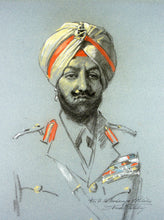Portrait of The Maharajah of Patiala by Frank Salisbury, 1935
Adding product to your cart
Overall: 67cm (26.5in) x 53.5cm (21in)
Charcoal and coloured chalk on grey paper. Signed and titled lower right.
The present portrait can be dated to Maharaja Bhupinder Singh of Patiala’s visit to London in 1935 for George V’s Silver Jubilee celebrations which culminated in a service of Thanksgiving held in St Paul’s Cathedral on 6 May. On this occasion Maharaja of Patiala acted as one of the King’s four honorary aides-de-camp, the others being the Maharaja of Bikanir, the Maharaja of Kashmir and Colonel Nawab Malik Sir Umar Hayat Khan. The day was one of national celebration and the service was conducted before a congregation of 5,000 and broadcast across the Empire. At the King’s command the artist Frank Salisbury was commissioned to capture the solemnity and splendour of the occasion in a massive painting entitled The Heart of Empire, 6th May 1935 (Royal Collection, RCIN 404703).
Read more
Salisbury had to work fast in order to make portrait studies of the various V.I.P’s in the painting while in London. Led by the King, the Royal family and they gave their time to Salisbury in a period he dubbed ‘RED HOT WEEK’. Portrait studies of the Maharaja of Bikanir, datable to 1 June from Salisbury’s sitter’s book, formed part of the artist’s studio until its dispersal in 1985. The present portrait, however, was retained by the artist’s family.
Maharaja Bhupinder Singh, G.C.S.I., G.C.I.E., G.C.V.O., G.B.E. (1891-1938) was Maharaja of Patiala from 1900 to 1938, and a first class cricketer. He came to the throne at the age of nine and assumed full ruling powers in 1910. His cricket and polo teams - Patiala XI and Patiala Tigers - were among the best of India. He captained the Indian cricket team that visited England in 1911 and played in 27 first-class matches between 1915 and 1937. He also played a season as a member of the M.C.C. in the 1920’s. During the First World War, he served on the General Staff in France, Belgium, Italy and Palestine, and was promoted Honorary Lieutenant-General in 1931. He was well known for the construction of buildings with bold architectural designs, including Kali Temple, Patiala, and Chail View Palace. He was chancellor of the Indian Chamber of Princes between 1926 and 1938, and worked tirelessly in many spheres for his subjects' betterment and introduced many social reforms. He married many times and had eighty-eight children by his wives and concubines. He was the proud owner of the world famous Cartier-made Patiala Necklace, and, according to legend, maintained a motorcade of twenty Rolls Royces. He was also the first man in India to own an aircraft, and formed what was at the time the world’s largest collection of medals.
Frank Owen Salisbury, LL.D., R.P., R.O.I. (1874-1962) rose from the lot of a lowly apprentice in a stained glass works in St. Albans, Hertfordshire to become one of the greatest society artists of his generation. Trained at the Royal Academy Schools, he was aided in his early career as portraitist by a co-congregationalist, the Methodist benefactor Lord Wakefield. During the First World War Salisbury was selected to paint the portrait of Boy Cornwell, V.C., the youthful hero of the Battle of Jutland in 1916. Such brought Salisbury to Royal notice and he was subsequently commissioned to paint The King and Queen visiting the Battle Districts of France, and by Royal Command, The Burial of the Unknown Warrior. Salisbury’s later portraits include many iconic images of national and international figures - the wartime ‘Blood, Sweat and Tears’ portrait of Churchill (formerly at 10 Downing Street), Montgomery standing before the wall map of Northwest Europe (National Portrait Gallery) and the official White House portrait of Franklin D. Roosevelt, among them. Salisbury’s great forte, however, was in his painting of large canvases of historical and national events, to which end the present portrait was executed.






